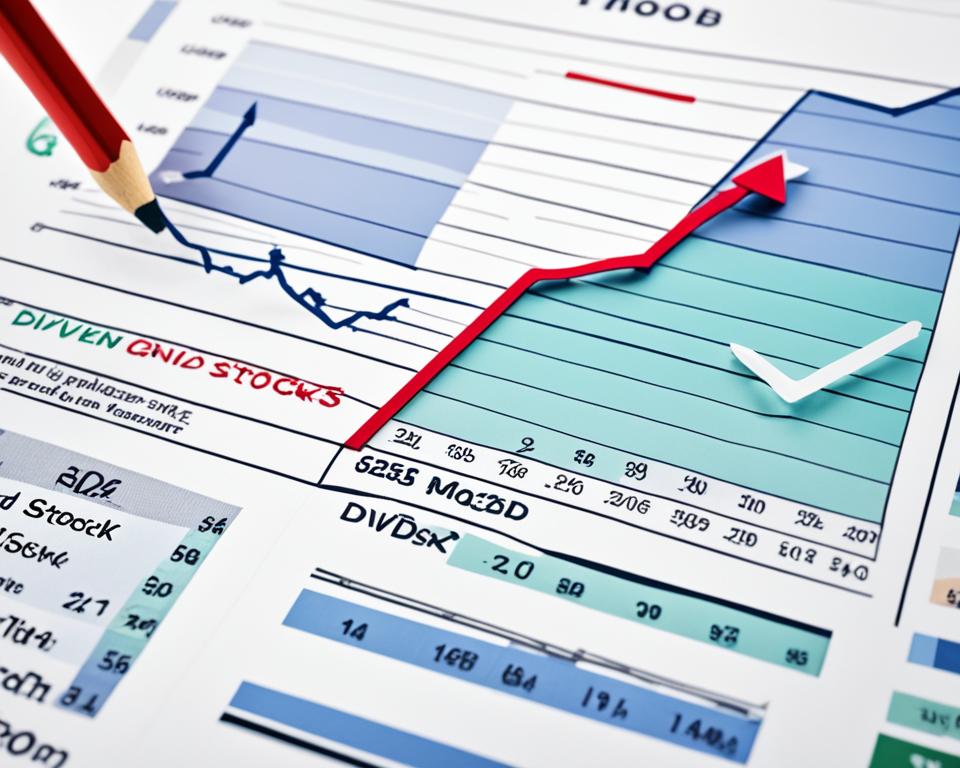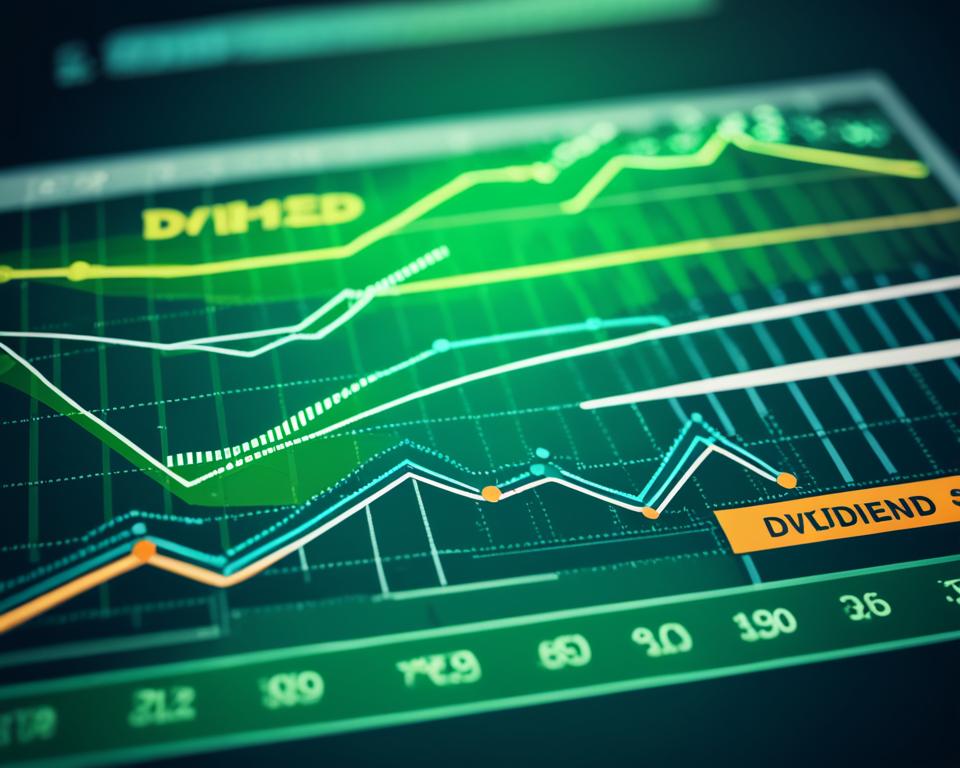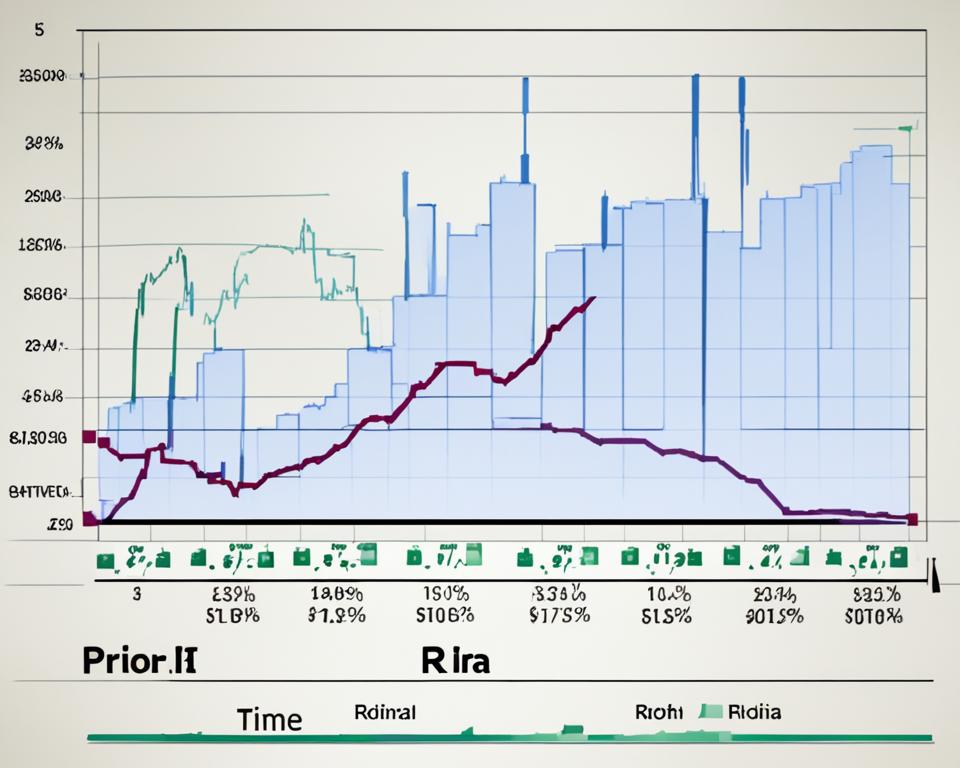One pivotal dilemma that often engulfs investors in a cloud of indecision is the choice between dividend and growth stocks. These seemingly divergent paths to potential returns each carry their distinct allure. Dividend stocks echo the promise of a reliable and potentially less risky cash flow as they offer investors a share of the company’s profits. Stakes in such companies provide consistent earnings, albeit perhaps suggesting a plateau in the growth curve of the establishment.
On the contrary, growth stocks pivot on the inherent reinvestment strategy. These are the stocks of companies that choose to fuel profits back into their operations, with a more long-term perspective. The aim is capital appreciation over time rather than immediate periodic returns to shareholders. In the dance between the dividend stocks vs growth stocks performance, the choice ultimately coalesces around the individual financial goals, risk tolerance, time horizon, and the need for immediate or future returns.
Key Takeaways
- Dividend stocks offer stable and recurrent dividends from a company’s profits, potentially suggesting lower risks but possibly limited growth.
- Growth stocks point towards reinvestment of profits back into the enterprise, aiming for capital appreciation, indicating a longer-term perspective, with possibly higher rewards but also amplified risks.
- One critical check for investing in dividend stocks is to assess the payout ratio – confirming the consistent cash flow of the company to comfortably cover this.
- Growth stock investments require a greater emotional resilience from investors given their relatively higher volatility.
- Evaluating the dividend stocks vs growth stocks comparison should be an individualistic choice based on personal financial goals, risk tolerance, and investment timeframe.
Understanding Dividend and Growth Investing Fundamentals
Investing in the stock market can be a lucrative endeavor when equipped with substantial knowledge, particularly understanding the difference between dividend and growth stocks investment. These two investment models offer varied approaches to generating returns and understanding them constitutes the bedrock of smart investing.
The Basics of Dividend Stocks
Dividend stocks refer to shares in companies that distribute a portion of their earnings to shareholders. The appeal of dividend stocks investing rests on its dual return strategy, yielding a steady stream of income in addition to potential capital appreciation. Dividend investing strategies are often decision-based on a high-dividend yield for immediate return, or a high-dividend growth rate seeking future gains.
The Growth Model’s Reinvestment Strategy
On the other end of the spectrum, growth stocks primarily represent companies invested in business expansion, with profits reinvested back into operations rather than paid out as dividends. The draw of growth stocks investing is its robust potential for capital appreciation over time, albeit, often coupled with a higher risk of volatility and potential financial issues in escalating interest rate environments.
Comparing Returns: Dividends vs. Growth
Comparing returns between the two can shed light on a comprehensive dividend stocks vs growth stocks analysis. Historical data showcases that dividend stocks have consistently outperformed growth stocks for investors with shorter investment timelines. In contrast, growth stocks offer considerable capital appreciation, suitable for those who can tolerate high volatility and prefer a longer investment term.
The Historical Performance of Dividend Stocks vs. Growth Stocks
When traversing the complex landscape of investing, a thorough understanding of historical performances can be instrumental. A stroll down the memory lane of dividend stocks vs growth stocks returns provides us insights about their performances and potential risks involved.
Historically, dividend-paying stocks establish their reputation as a beacon of stability within the tumultuous markets. These securities are often backed by mature, well-established businesses that are less vulnerable to bankruptcy, providing a sense of security to investors.
However, when we compare the dividend stocks vs growth stocks performance history, it becomes evident that dividend stocks traditionally had a lower potential for growth.
In contrast, high-quality growth companies have outperformed over the long-term, despite their higher volatility and risk levels. Their resilience and ability to adapt give them potential for high rewards. They are seen as the harbingers of robust growth, their vigor attracting investors who can brave higher risk for the sake of substantial returns.
| Aspect | Dividend Stocks | Growth Stocks |
|---|---|---|
| Historical Performance | Consistent, lower growth | Higher growth, more volatile |
| Bankruptcy Likelihood | Lower | Higher |
| Investor Appeal | Those seeking steady income and lower risk | Those seeking high returns and can stomach volatility |
Investors approach each type of stock—dividend vs growth—with various considerations. While some actively seek the consistency offered by dividend stocks, others are captivated by the high reward potential of growth stocks. It’s this fine balance of consistency versus reward potential that forms the crux of the stock market decisions.
The Role of Market Conditions in Stock Performance
Market conditions significantly influence the performance of both dividend and growth stocks. Investor sentiment, which can oscillate between optimistic and pessimistic states based on various factors, may affect their preferences between these categories of stocks. During periods of market instability, clear trends often emerge regarding the type of stock that tends to outperform.
Examining Risk-off Environments
In risk-off environments, where investors become more cautious due to uncertainties or negative events, safer investment options tend to be favored. Dividend stocks, known for their reliable income streams and generally stable prices, can become attractive in these situations. These assets offer a form of regular returns, which can be especially appealing during periods when growth may be harder to come by. Hence, the dividend stocks vs growth stocks outlook can lean towards the former during risk-off periods.
Interest Rate Impacts and Investor Psychology
Interest rates are another crucial aspect of the broader market conditions affecting stock performance. Notably, changes in these rates can significantly impact the relative performance of dividend stocks and growth stocks. High interest rates can burden growth stocks, as they often indicate an economy attempting to slow down, while potentially boosting the attractiveness of dividend stocks and their regular yield. This dynamic underscore the importance of economic indicators and investor psychology in stock performance and investment decision-making.
Overall, understanding the impact of market conditions on the performance and prospects of dividend and growth stocks is key to crafting a resilient investment strategy. It enables investors to dynamically adjust their portfolios based on the prevailing economic environment and their individual investment objectives.
Dividend Stocks vs. Growth Stocks: A Risk and Return Analysis
Investing in dividend stocks vs growth stocks represents two markedly distinct strategies, each conducting its own risk-return equilibrium. A careful dissection of these depths facilitates a profound comprehension of their inherent dynamics, effectively empowering an investor to align their decisions with respective financial objects and risk inclinations.

Assessing Volatility and Return Potential
In the world of investments, dividend stocks have traditionally been the less risky bet, offering a steady stream of income to investors. With less exposure to market volatility, they are often regarded as a safer investment refuge but may offer comparatively lower returns. On the other hand, growth stocks, invigorating from the companies’ aggressive reinvestment strategies, carry a higher upside potential. However, this usually comes with a higher level of risk and market volatility, making the potential for impressive gains a double-edged sword.
Dividend Aristocrats as a Case Study
To further illustrate, an intriguing case study focuses on Dividend Aristocrats—enterprises celebrated for consistently elevating their dividends for at least 25 years, oftentimes for numerous decades. Symbolizing a lower-risk profile, these companies’ repetitive trajectory of dividend increases implies a robust financial strength and reliability. For investors craving stability, particularly as retirement nears, these aristocratic performers provide reassuring reinforcement to their portfolio.
Yet, investments in growth stocks have their own merits. Even with a higher degree of risk and volatility, they are likely to deliver ample returns for investors focused on the future. Although they may undergo substantial declines during market downturns, their potential for capital appreciation remains significant, underlining the complexity, and importantly, the uniqueness of the risk-return trade-off when considering between dividend stocks vs growth stocks investing.
How do dividend stocks perform compared to growth stocks
Investing in the stock market demands an understanding of various forms of investments. Predominantly, the debate narrows down to dividend stocks vs growth stocks. The decision to invest in either heavily corresponds to the investor’s individual financial goals, risk tolerance, and investment timeline.
Dividend stocks, noted for their stability, offer a consistent cash flow and are therefore favored by investors seeking a sturdy income source. However, they might not outshine when it comes to capital growth. Growth stocks, on the contrary, are generally the high-flyers during bullish markets, driving substantial returns. They are preferred by younger investors or those with a long-term investment outlook. But, these stocks may also see significant drops during market corrections, making them risky compared to their dividend counterparts.
| Dividend Stocks | Growth Stocks | |
|---|---|---|
| Performance | Offers consistent cash flow but limited capital appreciation | Often outperform in bull markets with potential for high returns but can see significant drops in bear markets |
| Risk | Generally lower risk due to stability | Might carry higher risk due to market volatility |
| Investor Profile | Preferred by those looking for stable income or with shorter investment horizon | Often chosen by younger or long-term investors eyeing higher returns |
To conclude, understanding how dividend stocks perform compared to growth stocks is crucial for the forecast of one’s investment journey. Considering different factors such as risk tolerance, financial goals, and the economic backdrop against which these stocks perform, can lead to a grounded investment decision.
Growth Prospects of Dividend Yielding vs. Non-dividend Stocks
Dividend stocks and growth stocks represent two critical investment paths, each with their unique benefits and considerations. The dividend stocks vs growth stocks returns comparison often diverges based on investor preference, time horizon, and risk tolerance.
Dividend stocks typically provide regular income through profit distributions and a balance of predictable returns. They are favored by investors seeking a steady and less risky income stream, particularly those closer to retirement or with a conservative outlook. However, these stocks, while reliable, may demonstrate limited growth prospects, primarily if the company distributes a significant portion of its profits as dividends instead of reinvesting in the business.
On the other hand, growth stocks have historically demonstrated potential for substantial capital appreciation. Often preferred by younger investors, these stocks are generally associated with rapidly-growing companies that reinvest earnings in business expansion, improvement, or innovation, contributing to larger future potential earnings. However, these potential returns often come at the cost of higher volatility and investment risk.
The question of growth prospects comparison between these two types of stocks ultimately comes down to an individual investor’s goals, risk tolerance, and investment horizon.
| Dividend Stocks | Growth Stocks | |
|---|---|---|
| Regular Income | Yes | No |
| Capital Appreciation | Potentially lower | Generally higher |
| Risk | Lower | Higher |
| Ideal for Investors | Nearing retirement or seeking stability | Younger age group or those with a higher risk appetite |
In conclusion, both dividend and growth stocks can serve a vital role in a diversified investment portfolio. By understanding the key characteristics and the growth potential of each, investors can make informed decisions best suited to their financial goals and risk tolerance.
Tax Implications for Dividend and Growth Investors
When navigating the investment landscape, considering the tax implications associated with different types of investments is crucial. This aspect becomes particularly relevant when deciding between dividend and growth stocks. This section dives into the tax nuances of these investment categories, including the treatment of qualified dividends and capital gains tax.
Understanding Qualified Dividends
Dividends can be an attractive source of income for many investors, especially those in lower tax brackets. However, not all dividends are created equal. In the United States, qualified dividends are taxed at a more favorable rate compared to ordinary income. This potential advantage arises from the taxation system which categorizes qualified dividends as capital gains. Therefore, these dividends, if held for a certain period, may be subjected to a lower tax rate.
Capital Gains Tax and Growth Stock Investments
Growth stocks, on the other hand, typically incur capital gains tax upon the sale of the investment. The rate at which these gains are taxed can differ based on the holding period. Specifically, long-term investments, held for more than a year, can benefit from a lower capital gains tax rate compared to short-term investments. This difference in tax treatment may influence an investor’s decision on when to sell their growth stocks.
Understanding these tax implications is an important part of developing a robust investment strategy. Always consult with a qualified tax advisor to ensure that your investment decisions align with your specific tax circumstances and larger financial goals. Here is a simplified table that outlines the typical tax treatment for both qualified dividends and capital gains.
| Type | Short-term | Long-term |
|---|---|---|
| Qualified Dividends | Taxed as ordinary income | 0%, 15% or 20% based on income |
| Capital Gains from Growth Stocks | Taxed as ordinary income | 0%, 15% or 20% based on income |
Ultimately, the choice between dividend stocks and growth stocks goes beyond just potential returns. It involves a comprehensive understanding of numerous factors, including the investor’s tax bracket, overall financial needs, and long-term investment goals.
Portfolio Diversification: Balancing Dividend and Growth Stocks
In the complex world of investing, embracing a balanced portfolio can potentially offer both security and reward. This equilibrium often involves a mix of dividend stocks and growth stocks. Let’s explore why this balanced approach holds the key to successful investing.

A well-diversified portfolio, encompassing both dividend-paying and growth-oriented securities, ensures that investors can counter various market phases with confidence. This balancing act is particularly advantageous in mitigating risks, often synonymous with investing.
An investor needs to be adequately prepared for varying situations – market volatility, economic shifts, or unexpected personal needs. It’s in these predicaments that a diversified portfolio can prove its worth.
Diversification isn’t a simple act of selecting a handful of securities; it requires meticulous planning and understanding of one’s financial goals and risk tolerance. More importantly, it demands an intimate knowledge of one’s investor profile.
The investor profile is not static; it evolves with time. Factors contributing to this evolution include the investor’s financial commitments, age, income, and risk appetite. Consequently, the choice of dividend stocks vs growth stocks investing often varies along these timelines. The key lies in being able to adapt with time and retrospect one’s decisions.
The appeal of dividend stocks typically lies in the consistent income they generate over time. This dependable return finds favor with investors seeking stability or those nearing retirement. Growth stocks, on the other hand, tend to lure investors with their substantial potential for price appreciation, making them a preferable choice for those with a longer investment horizon or higher risk tolerance.
- Identify long-term financial goals and investment horizon
- Define risk tolerance
- Evaluate respective advantages of dividend and growth stocks
- Balance portfolio according to the above factors for optimal security and growth potential
In conclusion, a diversified portfolio that balances dividend and growth stocks suits a myriad of investors. By understanding their investment profile, individuals can adapt their allocation across these security types to achieve an optimal blend. This fine tuning can potentially ensure peace of mind while moving steadfastly towards their financial goals.
Dividend Stocks as a Long-term Investment Strategy
As investors navigate the complex terrain of financial investments, dividend stocks emerge as a solid bedrock anchoring a long-term investment strategy. Offering a blend of stability and steady passive income, these stocks cater particularly to investors nearing retirement or those who prioritize capital preservation. Let’s delve further into the factors that make dividend stocks a pivotal part of an investment portfolio.
Stability and Passive Income
One key drawing card to dividend stocks is the stability they bring to the economic roller coaster ride, cushioning investors against financial shocks with their predictable returns. Additionally, such investments help in crafting a consistent source of passive income, augmenting the financial safety net especially during lower earning periods or retirement.
Considering the Payout Ratio and Dividend Sustainability
Smart selection of dividend stocks directs focus on companies with sustainable dividends. A crucial indicator here is the payout ratio – the percentage of earnings a company pays out as dividends to its shareholders. A careful appraisal of this metric ensures that the dividends are within the company’s cash flow comfort zone, confirming their sustainability and the possible continuity of dividend stocks returns.
To round off, dividend stocks form an integral part of a long-term investment strategy, seamlessly aligning with the enduring goal of financial security.
Lifecycle of Businesses and Its Effect on Stock Category Performance
The life cycle of a business has a significant influence on whether it is categorized as either a dividend or a growth stock. This has critical implications on the investment performance linked to each category. Let’s delve further into how stages of business development can affect investing approaches and stock performance.
From Raising Capital to Returning Capital
Businesses in their initial capital-raising stages usually display growth stock characteristics. These companies require continuous funding for expansion, innovation, and to establish dominance within their respective sectors. As they mature and become self-sustaining, they may evolve into dividend stocks. The reinvestment of profits is then employed to facilitate steady growth during this phase.
Growth Cycles and Their Impact on Investing Approaches
Eventually, as businesses reach a point of maturity and saturation within the market, they transition into the capital-returning phase. This is often seen in the form of dividend issuance, appealing to investors looking for steady returns complemented by lower risk. Recognizing these stages of a company’s lifecycle, from a growth-oriented firm to a dividend-issuing enterprise, is crucial for investors to align their strategies with expected performance outcomes.
A comparison chart below illustrates how the dividend stocks outlook and the growth stock investment approach may change in correlation with the stages in the business life cycle.
| Business Life Cycle Stage | Stock Category | Investor Outcome |
|---|---|---|
| Capital Raising Stage | Growth Stock | Potential for high returns, higher volatility |
| Self-Funding Stage | Transitioning Stock | Balance between growth and income |
| Returning Capital Stage | Dividend Stock | Steady returns, lower volatility |
This cyclical pattern necessitates a different investment approach depending on the investor’s financial goals, risk tolerance, and time horizon. With the possibility of higher returns, growth stocks are suitable for investors who are able to tolerate higher market volatility. On the other hand, dividend stocks can provide consistent income with less risk, making them ideal for investors seeking stability and reliable returns.
Comparative Analysis of Blue-Chip Dividend Stocks and High-Growth Stocks
In the vast investing universe, blue-chip dividend stocks and high-growth stocks present contrasting prospects. By examining case studies of leaders in both sectors and their performance in various market conditions, investors can gain a deeper understanding of these investment avenues’ distinct attributes.
Case Studies of Market Leaders in Both Sectors
Consider the examples of AT&T, a prominent blue-chip dividend stock, and Tesla, a prime representation of high-growth stocks, to illustrate the unique characteristics and performance indicators for each sector. Both companies offer investment opportunities, but their path to returns and risks diverge significantly.
| AT&T (Blue-chip Dividend Stock) | Tesla (High-growth Stock) | |
|---|---|---|
| Stability in Returns | High | Low |
| Growth Potential | Low | High |
| Impact from Market Fluctuations | Low | High |
| Degree of Risk | Low | High |
Stock Performance in Bull vs. Bear Markets
Historically, blue-chip dividend stocks like AT&T have shown resilience during bear markets, offering stability in returns due to their established market presence. In stark contrast, high-growth stocks like Tesla have demonstrated remarkable price appreciation during bull markets, capturing substantial returns for investors. However, they also pose greater risks, subjecting investors to larger losses during market downturns.
To reap the rewards of these investment avenues, it is essential for investors to consider their risk appetite, market trends, and company fundamentals. Understanding the distinction between blue-chip dividend stocks and high-growth stocks, investors can craft an investment strategy that not only aligns with their financial goals but also provides the necessary balance in their portfolio.
Conclusion
Investing, as intricate and compelling as it may be, doesn’t present a cut-and-dry solution when it comes to the superiority of dividend stocks vs growth stocks. Each kind of investment serves different financial purposes, catering to a diverse range of investor needs. The investment decision is heavily reliant on financial objectives, risk tolerance levels, and investment timeframes.
Dividend stocks offer a predictable stream of income and are usually marked by financial stability. However, they may not present the same growth potential as their counterparts, the growth stocks. On the other hand, growth stocks hold the allure and potential of substantial capital appreciation. But investors should be aware that these usually come with a higher level of volatility.
For most investors, striking a balance between both types within a diversified portfolio can present the best of both worlds. This allows investors to benefit from the security of dividend stocks whilst also enjoying the growth potential offered by growth stocks. Ultimately, understanding the distinct attributes, market implications, and tax matters associated with each type is crucial for investors to make the most informed decision. This will pave the way towards achieving their long-term financial goals.
FAQ
How do dividend stocks perform compared to growth stocks over the long term?
Over the long run, dividend stocks have often provided consistent, predictable returns while growth stocks have the potential for higher capital appreciation. However, growth stocks usually bear higher levels of volatility and might be subject to sharp declines during market downturns. Your choice between the two will depend on your financial goals, risk tolerance, and investment horizon.
What are the basics of dividend and growth investing?
Dividend investing focuses on gaining income from a company’s distributed profits to shareholders. In contrast, growth investing involves directing profits back into business expansion, aiming for capital appreciation through the increase in its asset value over time. The choice to invest in either depends on your investment strategy and financial objectives.
How has the historical performance of dividend stocks compared to growth stocks?
Historically, dividend-paying stocks, often mature and well-established companies, have been seen as less risky with a lower bankruptcy likelihood. However, they may have lower growth potential compared to growth stocks. Growth companies, on the other hand, have demonstrated superior long-term performances, albeit marked with higher volatility and risk.
How do market conditions affect the performance of dividend and growth stocks?
Market conditions play a crucial role in the performance of dividend versus growth stocks. In risk-off environments, investors may lean towards dividend stocks as a safer option, while growth stocks may be more attractive when their prices significantly drop. Furthermore, the stage of a company in its life cycle can influence the investment attractiveness and associated risk.
What is a risk and return comparison of dividend and growth stocks?
Dividend stocks traditionally offer lower risk but with potentially lower returns, while growth stocks promise higher upside potential but are associated with increased volatility due to aggressive reinvestment. As an investor, you need to assess your risk tolerance and return expectations when investing in either.
What are the growth prospects of dividend-yielding vs. non-dividend stocks?
Dividend-yielding stocks provide consistent passive income, while non-dividend stocks, or growth stocks, have historically offered the potential for superior capital gains. It ultimately depends on your investment objectives and need for immediate cash flow versus long-term growth.
What are the tax implications for dividend and growth investors?
Qualified dividends are often taxed at a lower rate compared to ordinary income, potentially benefiting those in lower tax brackets. On the other hand, capital gains tax applies to growth stocks upon their sale, with long-term investments typically taxed at a lower rate. It’s crucial to understand these implications and consult a tax advisor to maximize your investment strategy’s efficiency.
What is the role of portfolio diversification in balancing dividend and growth stocks?
A balanced investment strategy often includes both dividend and growth stocks to mitigate risk across various market conditions, providing a mix of stable, income-generating assets and high-potential growth securities. Recognizing your risk preferences and investment horizon will help tailor your portfolio allocation to achieve an optimal blend of securities.
How does the life cycle of businesses affect stock category performance?
The life cycle of a business heavily influences the categorization of a company as either a dividend or a growth stock. Businesses in capital-raising stages often fall under growth stocks requiring continuous funding for expansion. As they mature and progress into self-funding and capital-returning phases, they often shift to issuing dividends, catering to investors seeking steady returns.
How do blue-chip dividend stocks and high-growth stocks compare in terms of performance across market conditions?
Blue-chip dividend stocks often offer steady returns and may be less impacted by bear markets. Conversely, high-growth stocks may exhibit significant appreciation during bull markets but are subject to larger downturns during market corrections. In each case, the investor must be mindful of market trends, company fundamentals, and their risk appetite before investment.












